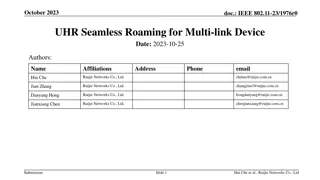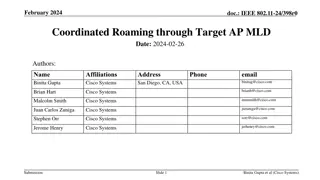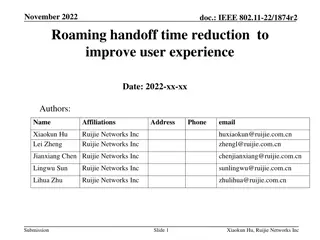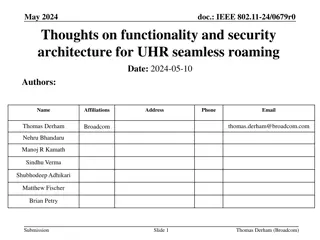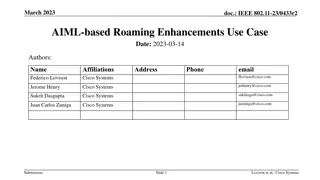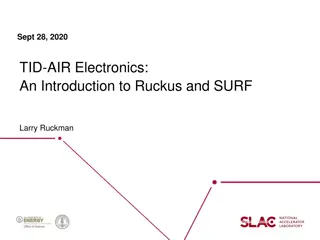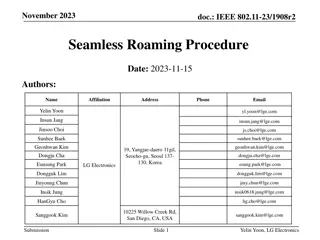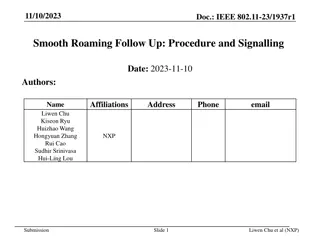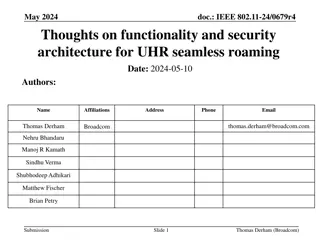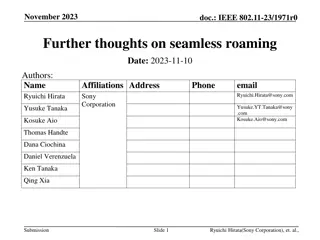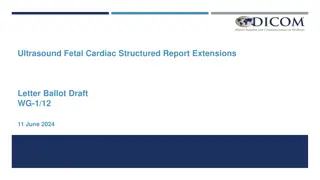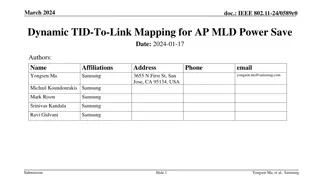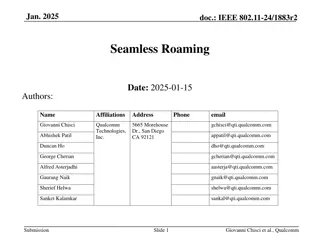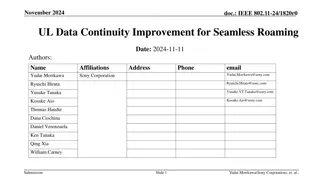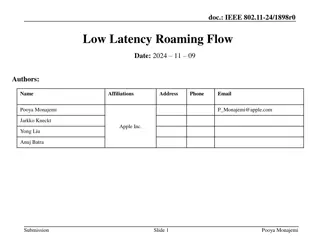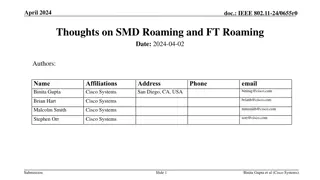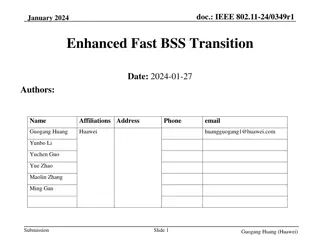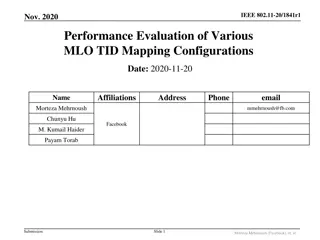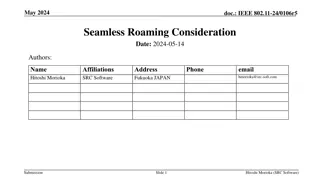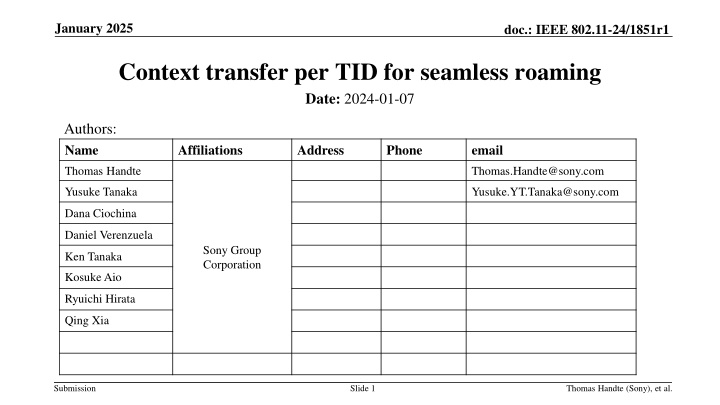
IEEE 802.11-24/1851r1 Seamless Roaming Context Transfer TID Study
Explore the detailed examination of context transfer per TID for seamless roaming in IEEE 802.11-24/1851r1 document. This study delves into the critical phases, context information division, and the transfer process for static and dynamic contexts. Discover how the separation and optimization of context transfer per TID can enhance user experience during roaming.
Download Presentation

Please find below an Image/Link to download the presentation.
The content on the website is provided AS IS for your information and personal use only. It may not be sold, licensed, or shared on other websites without obtaining consent from the author. If you encounter any issues during the download, it is possible that the publisher has removed the file from their server.
You are allowed to download the files provided on this website for personal or commercial use, subject to the condition that they are used lawfully. All files are the property of their respective owners.
The content on the website is provided AS IS for your information and personal use only. It may not be sold, licensed, or shared on other websites without obtaining consent from the author.
E N D
Presentation Transcript
January 2025 doc.: IEEE 802.11-24/1851r1 Context transfer per TID for seamless roaming Date: 2024-01-07 Authors: Name Affiliations Address Phone email Thomas Handte Thomas.Handte@sony.com Yusuke Tanaka Yusuke.YT.Tanaka@sony.com Dana Ciochina Daniel Verenzuela Sony Group Corporation Ken Tanaka Kosuke Aio Ryuichi Hirata Qing Xia Submission Slide 1 Thomas Handte (Sony), et al.
January 2025 doc.: IEEE 802.11-24/1851r1 Introduction Seamless roaming has been addressed in numerous contributions e.g. [1-13] Submissions address architecture, data flow, context transfer, and security aspects Six SFD entries capture the current consensus on seamless roaming operation [14] In order to make the roaming truly seamless, its critical phase needs to be carefully considered [1-3] The critical phase starts with initiation of the context transfer, and ends after the DS mapping changed to target AP During this time span, the data service to/from a non-AP MLD is limited Only buffered downlink (DL) data can be conveyed to the non-AP MLD No uplink (UL) data can be conveyed to source or target AP This submission addresses context information and its separation A context transfer per TID can limit the impact of the critical phase contributing to enhanced user experience Submission 2 Thomas Handte (Sony), et al.
January 2025 doc.: IEEE 802.11-24/1851r1 Context information Several submissions address information within the context Context information may be divided into a rather static and a dynamic part [1-8] Information to be included contains PMK/PTK [4, 7, 9] BAck context [4, 7-11] Agreements (e.g. SCS, MSCS, TWT) [7, 9, 11] Packet number [4-5, 9] Sequence number [1, 4-5, 8-10] Capabilities [4] Content of transmit buffer (aka data forwarding) may be useful [9, 12-13] The context information above is Valid for all TIDs but rather static (e.g. PTK, agreements), or TID specific (e.g. sequence number, BAck context, transmit and receive buffer), or evaluated per TID (packet number) Submission 3 Thomas Handte (Sony), et al.
January 2025 doc.: IEEE 802.11-24/1851r1 Context transfer per TID Initially, static context is transferred Includes PMK/PTK, agreements, PN PN space may be split into lower and higher part; lower/ higher part stays with source/ target AP [5] Subsequently, dynamic context is transferred per TID Order of transferred TIDs and/or context aggregation of several TIDs can be optimized and is implementation dependent For example, high priority TIDs can be transferred first TIDs with currently empty buffer can be transferred first There is no DL/UL data service for the currently transferred TID except buffered DL Submission 4 Thomas Handte (Sony), et al.
January 2025 doc.: IEEE 802.11-24/1851r1 DS mapping and data forwarding DS mapping Initially DS mapping is to source AP and stays with source AP even though the dynamic context of a TID has been transferred Data forwarding While DS mapping is with source AP, data units of those TIDs whose context has been transferred to target AP are forwarded from source to target AP in downlink (DL) are forwarded from target to source AP in uplink (UL) While DS mapping is with source AP, data units of those TIDs whose context has not been transferred to target AP are normally processed Submission 5 Thomas Handte (Sony), et al.
January 2025 doc.: IEEE 802.11-24/1851r1 Data flows The data flow to/from non-AP MLD depends on DS mapping, used TID, and status of the TID (transferred to target AP or not) The data flow is (before first TID is transferred) DS source AP non-AP MLD (after first TID is transferred) DS source AP non-AP MLD for non-transferred TIDs or DS source AP target AP non-AP MLD for transferred TIDs (after DS mapping change) DS target AP non-AP MLD Note that Buffered DL data can be served by source AP at any time DS mapping change can happen before the last TID is transferred (example see Appendix) Submission 6 Thomas Handte (Sony), et al.
January 2025 doc.: IEEE 802.11-24/1851r1 Benefits Data service interruption during roaming is just for one TID, not for all The information fragments transferred during context transfer are smaller Service interruption for one TID is shorter compared to all TID transfer Roaming is future-ready i.e., two APs can serve a non-AP MLD at same time For the application of seamless roaming, this state is transient Data forwarding just applies during a transient phase Thus, the DS load is only increased while not all TIDs are transferred Afterwards, the DS mapping is changed, and DS load is back to normal Adjust context transfer to buffer status of certain TIDs Transferring TIDs with empty buffer saves time for emptying or forwarding the buffer content Submission 7 Thomas Handte (Sony), et al.
January 2025 doc.: IEEE 802.11-24/1851r1 Conclusion Context transfer is the critical phase in seamless roaming During this phase data service to/ from non-AP MLD is limited which degrades user experience We suggest to implement a TID specific context transfer Initially (rather) static context is transferred from source to target AP Subsequently, the dynamic context of each TID is transferred until the entire context is with target AP DL/UL data service to a non-AP MLD can be maintained during the context transfer for all TIDs except the currently transferred TID Data service for non-transferred TIDs is provided by the source AP, which is connected to the DS Data service for transferred TIDs is provided by the target AP, which receives/ forwards data from/ to the source AP connected to the DS We see significant benefits such as Quasi uninterrupted data flow during seamless roaming Future readiness of roaming architecture for applications beyond seamless roaming Submission 8 Thomas Handte (Sony), et al.
January 2025 doc.: IEEE 802.11-24/1851r1 References [1] 11-24/1898 Low Latency Roaming Flow [2] 11-24/1883 Seamless Roaming [3] 11-24/1882 Link Setup for Seamless Roaming [4] 11-24/1812 Seamless roaming through a target AP follow up [5] 11-24/0052 Seamless Roaming details [6] 11-24/1884 Seamless Roaming [7] 11-24/0396 Seamless roaming within a mobility domain - follow up [8] 11-24/0830 Improve roaming between MLDs follow up [9] 11-24/101 MLD roaming [10] 11-24/830 Improve roaming between MLDs follow up [11] 11-24/679 Thoughts on Functionality and Security Architecture for UHR Seamless Roaming [12] 11-24/1740 UL Data Transmission for Seamless Roaming [13] 11-24/1517 Seamless Roaming Data Transfer [14] 11-24/0209 Specification Framework for TGbn Submission 9 Thomas Handte (Sony), et al.
January 2025 doc.: IEEE 802.11-24/1851r1 APPENDIX Submission 10 Thomas Handte (Sony), et al.
January 2025 doc.: IEEE 802.11-24/1851r1 Data flows The following diagram shows the data flows, when DS mapping change is before last TID transferred For example, a DS mapping change before the last TID is transferred may make sense when half of the TIDs have been transferred If TIDs are equally used, the DS load due to data forwarding is minimized Submission 11 Thomas Handte (Sony), et al.
January 2025 doc.: IEEE 802.11-24/1851r1 SP #1 Do you agree to add the following to the SFD? As part of the seamless roaming procedure, the context information is transferred per TID from the current to the target AP MLD. Submission 12 Thomas Handte (Sony), et al.
January 2025 doc.: IEEE 802.11-24/1851r1 SP #2 Do you agree to add the following to the SFD? As part of the seamless roaming procedure, during roaming, the target AP MLD may forward uplink data to the current AP MLD. - when and how to initiate the forwarding of uplink data is TBD. Submission 13 Thomas Handte (Sony), et al.
January 2025 doc.: IEEE 802.11-24/1851r1 SP #3 Do you agree to add the following to the SFD? As part of the seamless roaming procedure, if the context information is transferred per TID from the current to the target AP MLD. - The AP MLD which is connected to the DS (AP1) forwards DL data units to the AP MLD which is not connected to the DS (AP2) for TIDs that have been transferred to AP2. - The AP MLD which is not connected to the DS (AP2) forwards UL data units to the AP MLD which is connected to the DS (AP1). Submission 14 Thomas Handte (Sony), et al.

